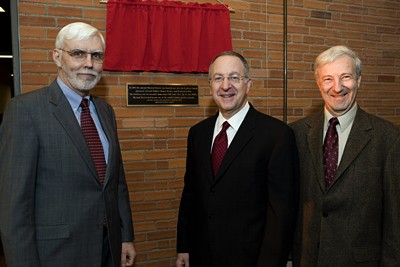Plaque is dedicated in Rockefeller, recognizing birth of Physical Review at Cornell
By Anne Ju
In 1893 three Cornell physicists with no peer-reviewed journal to call their own took matters into their own hands, founding the Physical Review. Those visionaries, Edward Nichols, Ernest Merritt and Frederick Bedell, were the fathers of the now-famous and internationally respected Physical Review.
The history of the journal was celebrated at Cornell March 3, with the unveiling of a plaque in Rockefeller Hall, where the journal was originally published. Representatives from the American Physical Society (APS), which took over publishing the journal in 1913, were on hand to mark the occasion. The plaque, just outside Schwartz Auditorium, marks Cornell's inclusion on the APS Register of Historic Sites.
Before the plaque unveiling, Mildred Dresselhaus, Institute Professor of Electrical Engineering and Physics at the Massachusetts Institute of Technology, presented a physics colloquium to the roomful of people gathered in Schwartz Auditorium.
Physical Review Editor-in-Chief Gene Sprouse described how the journal's fundamental reliance on peer review has made it withstand the test of time and has allowed it to grow in scope and breadth. He also announced that the journal will be awarding 1 percent of its peer reviewers "Outstanding Referee Awards," the first of which he presented to Dresselhaus during his remarks.
It was an "amazingly bold and brave" move at the time for Nichols, Merritt and Bedell to found a peer-reviewed journal exclusively for physics, said APS treasurer Joseph Serene, but he also called it a "remarkable act of service" for which the editors today are still grateful.
Cornell President David Skorton added his praise to the physics department and described the ongoing project of the new physical sciences building, slated for completion in 2010, which will be the new home for the physics department, among others.
Media Contact
Get Cornell news delivered right to your inbox.
Subscribe